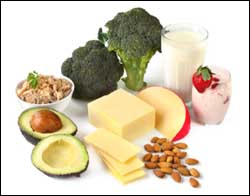Calcium: A Bone’s Best Friend – Needs Change as We Age
- By Rebecca Taggart
- Reading Time: 3 mins.
Calcium and phosphorus are critical minerals that form the basic building block of bones and teeth, giving them both strength and density. Calcium is also essential to nerve and muscle function, blood clotting, enzyme and hormone regulation, and cell membrane function. When we don’t consume adequate amounts of calcium through food or supplements, our bodies take what is needed from our bones, which over time can lead to osteoporosis.

Osteoporosis, characterized by porous and fragile bones, will affect half of all American women, according to the National Institutes of Health. Less well known is that one in four men over age 50 will have an osteoporosis-related fracture in their lifetime. Inadequate calcium intake in childhood and/or adulthood is usually a critical contributing factor to osteoporosis. Research shows that getting enough calcium helps prevent breast and colorectal cancer, high blood pressure, and obesity.
Our calcium needs change over our lifetimes as the rate of bone growth changes. Babies and children need sufficient calcium to grow normally, yet we need the most calcium during the pre-adolescent and teenage years when bones grow tremendously in length. The teenage years represent a once-in-a-lifetime chance to build bones. By age 18, we have already made most of the skeleton that will support us the rest of our lives.
Calcium needs by age, according to the NIH:
- Children ages 4 to 9, at least 800 mg of calcium per day
- Girls age 10-18 and boys 12-18, 1,300 mg
- Adults ages 19-50, 1,000 mg
- Adults age 50+ need at least 1,200 mg
So is it all over for those of us over 18? Not at all. We continue to add density to our bones up until about age 30-35, assuming we consume at least 1000 mg of calcium daily. After age 35, we begin to lose bone density.
Get tips for your office
Be an office hero!Nonetheless keeping our blood calcium levels up by ingesting at least 1,000 mg daily after age 35 keeps our bodies from robbing our bones to supply the many essential functions that need calcium, and thus slows bone loss. After age 50, our needs increase again to at least 1,200 mg, partly because as we age, we produce less stomach acid, which is necessary for calcium absorption. Post-menopausal women are especially at risk because lower estrogen levels mean bones lose calcium more quickly.
Most Americans consume less than adequate amounts of calcium. So where can you get the calcium you need? In general, calcium is better absorbed from food sources than from supplements. There are trace amounts of calcium in most foods, but here are some with higher amounts:
- Low-fat yogurt, one cup, about 415mg calcium
- Milk, one cup, about 300mg
- Cheddar cheese, one ounce, about 200mg
- Ricotta cheese, one cup, about 509mg
- Spinach, one cup cooked, 245mg
- Collard or turnip greens, one cup cooked, about 200mg
- Swiss chard or mustard greens, about 100mg
- Broccoli, half cup cooked, 35mg
- Black-eyed peas, one cup cooked, 211mg
- Sardines, small can with the bones (3.5 oz), 325mg
- Baking powder, 1 teaspoon, 200-300mg
Surprisingly, two teaspoons of blackstrap molasses provide 12% RDV and 1/4 cup sesame seeds yields about 35%.
Supplements are another way to give our body additional calcium but remember that our bodies have trouble absorbing more than 500 mg at a time, so tablets with more than this amount may deliver diminished results. Chelated calcium, such as calcium citrate, is more readily absorbed than calcium carbonate, the cheaper form usually found in fortified juices, antacid tablets, and many calcium supplements. If your supplement contains calcium carbonate, take it with a meal to help improve absorption. Vitamin D enhances the absorption of all forms of calcium, so supplements that combine both calcium and Vitamin D are best. Magnesium is also vital for bones but interferes with calcium absorption, so avoid supplements that combine these nutrients. Calcium interferes with iron absorption, so again avoid supplements that combine the two. MIT provides detailed information on essential minerals here.
Get tips for your office
Be an office hero!In addition to calcium, bones require exercise to encourage calcium absorption. Walking, running, weight-resistant workouts, and anything where the feet leave the ground all help increase bone density, especially in adolescence and early adulthood. If you have children, especially girls, encourage a calcium-rich diet with plenty of exercises to develop strong bones and help prevent osteoporosis after menopause.
Rebecca Taggart is a San Franciso–based yoga instructor.
Information in this article is not intended for medical advice. Always consult your doctor or health professional before beginning a new exercise program or introducing new supplements.


